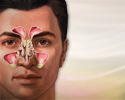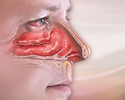Stuffy or runny nose – adult
Nose - congested; Congested nose; Runny nose; Postnasal drip; Rhinorrhea; Nasal congestionA stuffy or congested nose occurs when the tissues lining it become swollen. The swelling is due to inflamed blood vessels.
The problem may also include nasal discharge or "runny nose." If excess mucus runs down the back of your throat (postnasal drip), it may cause a cough or sore throat.
Causes
A stuffy or runny nose may be caused by:
-
Common cold
Common cold
The common cold most often causes a runny nose, nasal congestion, and sneezing. You may also have a sore throat, cough, headache, or other symptoms....
 ImageRead Article Now Book Mark Article
ImageRead Article Now Book Mark Article -
Flu
Flu
The flu (influenza) is a viral respiratory illness that causes fever, chills, runny nose, body aches, and cough. It spreads easily from person to pe...
 ImageRead Article Now Book Mark Article
ImageRead Article Now Book Mark Article -
Sinus infection
Sinus infection
Sinusitis is present when the tissue lining the sinuses become swollen or inflamed. It occurs as the result of an inflammatory reaction or an infect...
 ImageRead Article Now Book Mark Article
ImageRead Article Now Book Mark Article
The congestion typically goes away by itself within a week.
Congestion also can be caused by:
-
Hay fever or other allergies
Hay fever
Allergic rhinitis is a diagnosis associated with a group of symptoms affecting the nose. These symptoms occur when you breathe in something you are ...
 ImageRead Article Now Book Mark Article
ImageRead Article Now Book Mark Article - Use of some nasal sprays or drops bought without a prescription for more than 3 days (may make nasal stuffiness worse)
-
Nasal polyps, sac-like growths of inflamed tissue lining the nose or sinuses
Nasal polyps
Nasal polyps are soft, sac-like growths on the lining of the nose or sinuses.
 ImageRead Article Now Book Mark Article
ImageRead Article Now Book Mark Article - Pregnancy
-
Vasomotor rhinitis
Vasomotor rhinitis
Rhinitis is a condition that includes a runny nose, sneezing, and nasal stuffiness. When environmental allergies (such as hayfever) or a cold are no...
 ImageRead Article Now Book Mark Article
ImageRead Article Now Book Mark Article
Home Care
Finding ways to keep mucus thin will help it drain from your nose and sinuses and relieve your symptoms. Drinking plenty of clear fluids is one way to do this. You can also:
- Apply a warm, moist washcloth to your face several times a day.
- Inhale steam 2 to 4 times a day. One way to do this is to sit in the bathroom with the shower running. Do not inhale hot steam.
- Use a vaporizer or humidifier.
A nasal wash can help remove mucus from your nose.
- You can buy a saline spray at a drugstore or make one at home. To make one, use 1 cup (240 milliliters) of warm water, 1/2 teaspoon (3 grams) of salt, and a pinch of baking soda.
- Use gentle saline nasal sprays 3 to 4 times per day.
Congestion is often worse when lying down. Keep upright, or at least keep the head elevated.
Some stores sell adhesive strips that can be placed on the nose. These help widen the nostrils, making breathing easier.
Medicines you can buy at the store without a prescription can help your symptoms.
- Decongestants are medicines that shrink and dry up your nasal passages. They may help dry up a runny or stuffy nose.
-
Antihistamines are medicines that treat allergy symptoms. Some antihistamines make you drowsy, so use with care.
Antihistamines
An allergy is an immune response, or reaction, to substances (allergens) that are usually not harmful. In someone with allergies, the immune respons...
Read Article Now Book Mark Article - Nasal sprays can relieve stuffiness. Don't use over-the-counter nasal sprays more often than 3 days on and 3 days off, unless told to by your health care provider.
Many cough, allergy, and cold medicines you buy have more than one medicine inside. Read the labels carefully to make sure you don't take too much of any one medicine. Ask your provider which cold medicines are safe for you.
If you have allergies:
- Your provider may also prescribe nasal sprays that treat allergy symptoms.
- Learn how to avoid triggers that make allergies worse.
Allergies worse
Allergic rhinitis is a group of symptoms that affect your nose. They occur when you breathe in something you are allergic to, such as dust mites, an...
 ImageRead Article Now Book Mark Article
ImageRead Article Now Book Mark Article
When to Contact a Medical Professional
Contact your provider for any of the following:
- A stuffy nose with swelling of the forehead, eyes, side of the nose, or cheek, or that occurs with blurred vision
- More throat pain, or white or yellow spots on the tonsils or other parts of the throat
- Discharge from the nose that has a bad smell, comes from only one side, or is a color other than white or yellow
-
Cough that lasts longer than 10 days, or produces yellow-green or gray mucus
Cough
Coughing is an important way to keep your throat and airways clear. But too much coughing may mean you have a disease or disorder. Some coughs are d...
 ImageRead Article Now Book Mark Article
ImageRead Article Now Book Mark Article - Nasal discharge following a head injury
- Symptoms that last more than 3 weeks
- Nasal discharge with fever
Fever
Fever is the temporary increase in the body's temperature in response to a disease or illness. A child has a fever when the temperature is at or abov...
 ImageRead Article Now Book Mark Article
ImageRead Article Now Book Mark Article
What to Expect at Your Office Visit
Your provider may perform a physical exam that focuses on the ears, nose, throat, and airways.
Tests that may be done include:
-
Allergy skin tests
Allergy
An allergy is an immune response or reaction to substances that are usually not harmful.
 ImageRead Article Now Book Mark Article
ImageRead Article Now Book Mark Article - Blood tests
-
Sputum culture and throat culture
Sputum culture
Routine sputum culture is a laboratory test that looks for germs that cause infection. Sputum is the material that comes up from air passages when y...
 ImageRead Article Now Book Mark Article
ImageRead Article Now Book Mark ArticleThroat culture
A throat swab culture is a laboratory test that is done to identify germs that may cause infection in the throat. It is most often used to diagnose ...
 ImageRead Article Now Book Mark Article
ImageRead Article Now Book Mark Article -
X-rays of the sinuses and chest x-ray
X-rays of the sinuses
A skull x-ray is a picture of the bones surrounding the brain, including the facial bones, the nose, and the sinuses.
 ImageRead Article Now Book Mark Article
ImageRead Article Now Book Mark ArticleChest x-ray
A chest x-ray is an x-ray of the chest, lungs, heart, large arteries, ribs, and diaphragm.
 ImageRead Article Now Book Mark Article
ImageRead Article Now Book Mark Article
References
Bachert C, Zhang N, Gevaert P. Rhinosinusitis and nasal polyps. In: Burks AW, Holgate ST, O'Hehir RE, et al, eds. Middleton's Allergy: Principles and Practice. 9th ed. Philadelphia, PA: Elsevier; 2020:chap 41.
Corren J, Baroody FM, Togias A. Allergic and nonallergic rhinitis. In: Burks AW, Holgate ST, O'Hehir RE, et al, eds. Middleton's Allergy: Principles and Practice. 9th ed. Philadelphia, PA: Elsevier; 2020:chap 40.
Cohen YZ. The common cold. In: Bennett JE, Dolin R, Blaser MJ, eds. Mandell, Douglas, and Bennett's Principles and Practice of Infectious Diseases. 9th ed. Philadelphia, PA: Elsevier; 2020:chap 58.
-
How to use nasal sprays
Animation
-
Runny and stuffy nose - illustration
A runny or stuffy nose can be due to colds, allergies, sinus infections or the flu. When there is an excess of mucus secretions the nose is runny. The additional secretions drain from the front of the nose, or down the back (post-nasal drip). The sensation of a stuffy nose occurs when the membranes that line the nose become swollen from inflamed blood vessels.
Runny and stuffy nose
illustration
-
Runny and stuffy nose - illustration
A runny or stuffy nose can be due to colds, allergies, sinus infections or the flu. When there is an excess of mucus secretions the nose is runny. The additional secretions drain from the front of the nose, or down the back (post-nasal drip). The sensation of a stuffy nose occurs when the membranes that line the nose become swollen from inflamed blood vessels.
Runny and stuffy nose
illustration
-
Asthma
(Alt. Medicine)
-
Immunizations - InDepth
(In-Depth)
-
Benign prostatic hyperplasia - InDepth
(In-Depth)
Review Date: 7/8/2023
Reviewed By: Linda J. Vorvick, MD, Clinical Professor, Department of Family Medicine, UW Medicine, School of Medicine, University of Washington, Seattle, WA. Also reviewed by David C. Dugdale, MD, Medical Director, Brenda Conaway, Editorial Director, and the A.D.A.M. Editorial team.



